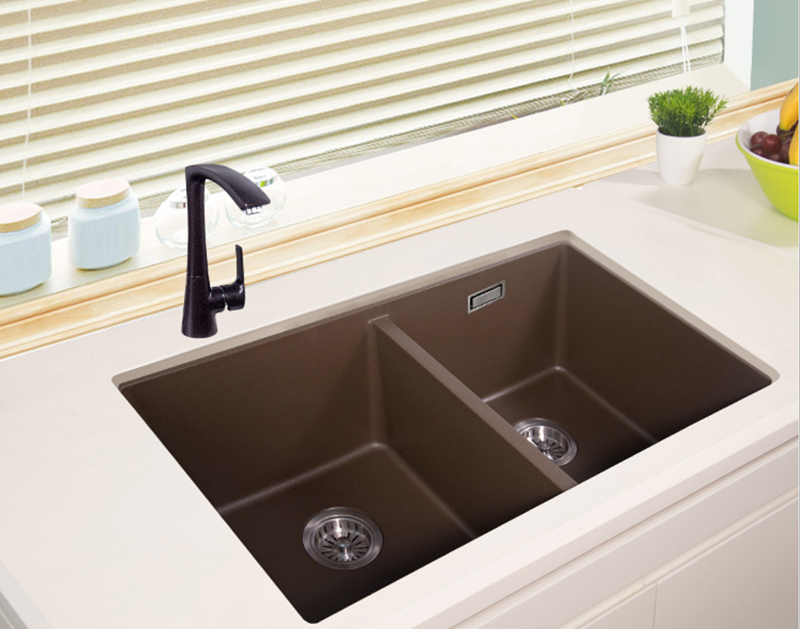As we all know that granite composite sinks are durable, but you might face some after-sale problems when selling them.
For instance, granite composite sinks are made of composite material that brings the crack in these sinks. Other problems that exist are discoloration and light color series bleeding.
This article highlights a few problems in these sinks and explains why these problems occur.
Cracks
Since these sinks are made of quartz sand mixed with resin, they may cause a crack due to the resin shrinks. Expansion and contraction is another reason for the crack in these sinks when exposed to temperatures.
Thus, the continuous change in size due to different temperatures brings about gaps. But, the problem of cracks might not be as severe. Since the 20% resin of content has a small shrinkage ratio, it does not always crack the sink.
Furthermore, these sinks go through another process during molding that helps to keep them stable. This process adds to the sink’s strength, but they still are prone to cracks and chipping.

Discoloration
Another problem that people face with granite composite sinks is discoloration. This is due to food and beverage spills that result in granite’s surface changing its color.
Water is constant during the usage of any sink. The main problem with granite composite sinks is that the sink’s body immediately turns white when hot water comes into contact with the sink’s surface, making it look dirty every time.
The patches of white on a dark-colored sink give an ugly impression. Granite composite sinks are uniform in pattern and color. But since it is challenging to maintain granite composite sinks, they start looking dirty with time.
Thus, their users are always in trouble regarding the upkeep of these sinks. However, many manufacturers have started to coat these sinks’ surfaces to prevent them from changing color. But this hasn’t proved to be successful as the coating falls off after several times of use, and customers are left facing the same issue.
This problem is mainly because of the low heat-resistance of the materials used in the manufacturing of granite composite sinks. The materials used have different properties at different temperatures, which causes small problems here and there.
You should know this before you invest in a granite composite sink.
Light Color Series Bleeding
Granite composite sinks are molded under high pressure, making them hygienic, nonporous, and resistant to heat, scratches, and chips. This also causes micron-sized pores to form on the surface of the quartz sink.
These micron-sized pores may cause problems on the sink’s surface, making some colors bleed into the sink easily. People are busy these days and do not have the time to sort out or do the dishes on time.
This leads to the dishes not being done and sitting in the sink for a few days. As a result, some light-colored quartz sinks will bleed, causing damage to the sink’s surface layer. To solve out this problem, you need to clean the sink frequently.

However, cleaning a quartz sink can be tricky as you can not use harsh chemicals. It can damage the sink, so follow the manufacturer’s recommendation to clean it.
Typically, for regular cleaning, you can use mild dish soap and water. For more resistant stains, put baking soda and vinegar into the sink and gently scrub the stain with a soft sponge.
Solution: Clean Your Sink Frequently
It might not be possible to completely eradicate the problems mentioned above, but the only way one can deal with them is through thorough cleaning. Granite composite sinks run the problem of discoloration, and its solution is not to use full strength bleaches but too frequently clean these sinks.
This will ensure that your sink doesn’t look dirty as dirty sinks signal lack of hygiene, and ugly-looking sinks can shatter one’s confidence since their kitchen won’t look presentable. But you should make sure that you clean them with soft fabric and mild soap after every use.
It would help if you did not use harsh implements on the sink top to avoid scratches. You need to clean the stains after every activity, so they don’t become harder.
Chica Granite Sinks
Chica granite sink can solve the problems mentioned above as it is composed of 80% quartz sand that transforms into a quality composite substance with advanced production methods. This guarantees the high quality of Chica granite composite sinks.
Chica granite composite sinks have 80% quartz sand and 20% acrylic, giving them strength and resilience in the kitchen. The material used during its production process helps it withstand the damage.
These sinks don’t spoil when exposed to hot pans, and they don’t cave into heavy materials placed on them. Also, they can withstand a temperature of 260 Degrees Celsius, which means usage of hot water won’t leave any marks or cause discoloration of these sinks.
These sinks are more crack and chip resistant as a tear line won’t run deep into Chica granite. A stain is the most frequent challenge faced by sink owners, but this problem can be efficiently dealt with as Chica granite composite sinks don’t leave stains.
Along with this, they are easy to maintain, which takes away many responsibilities from its users.
FILL IN THIS FORM TO REQUEST A QUICK QUOTE FROM CHICA DRAGON
Conclusion
Granite composite sinks offer durability, strength, and natural beauty. It brings an air of splendor to the kitchen, and its last-lasting abilities leave its customers satisfied.
However, they carry specific problems with them. These sinks start cracking, and their color fades with time leaving its users unsatisfied, unlike Chica granite composite sinks.
They have a smoother finish and are rich in appearance. One might have to pay higher for Chica granite sinks, but they are unmatchable, and they provide value for money.



